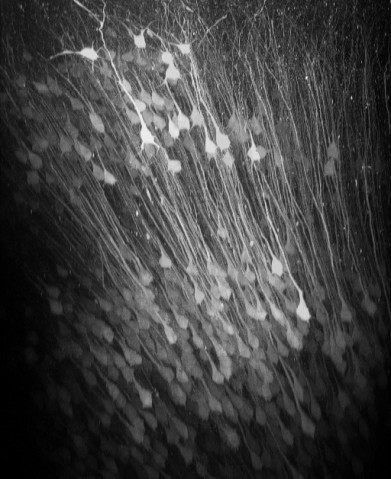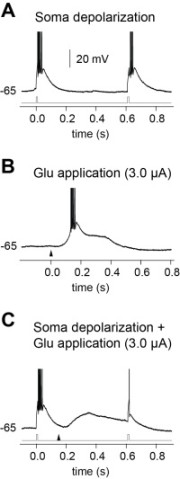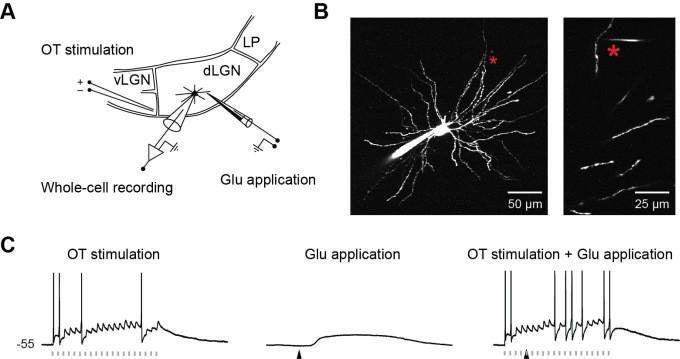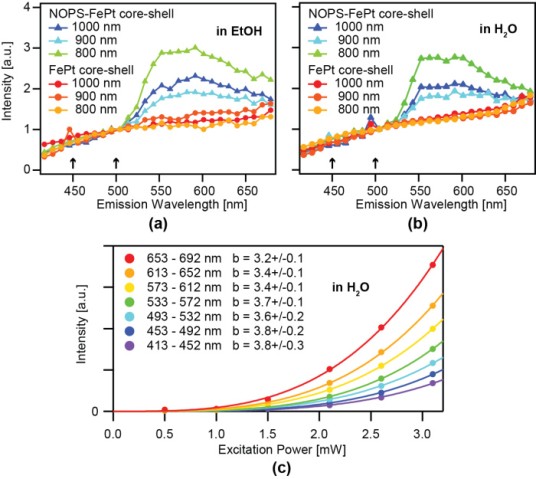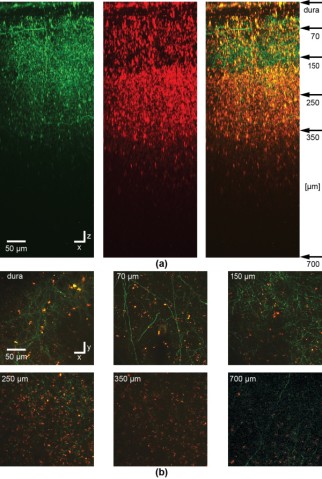Optical Neuroimaging Unit
Assistant Professor Bernd Kuhn
Abstract
In the FY 2013 the Optical Neuroimaging Unit continued several different in vivo imaging projects. Research projects focus on imaging neuronal activity in the mouse brain.
1. Staff
- Dr. Bernd Kuhn, Assistant Professor
- Dr. Sigita Augustinaite, Researcher
- Dr. Christopher J. Roome, Researcher
- Dr. Akihiro Funamizu, Researcher (shared with Doya Unit)
- Ryo Shiroishi, NAIST Master Student (shared with Doya Unit, until 8/2013)
- Dr. Kazuo Mori, Technical Assistant (from 3/2014)
- Dr. K. Kumkum Hossain, Technical Assistant (until 3/2014)
- Hiroko Chinone, Research Administrator
2. Collaborations
- Theme: Model-based decision making by two-photon microscopy
- Type of collaboration: Joint research
- Researchers:
- Professor Dr. Kenji Doya, Neural Computation Unit, OIST
- Dr. Akihiro Funamizu, Neural Computation Unit, OIST
- Ryo Shiroishi, Neural Computation Unit, OIST
- Theme: NMDA spikes in dendrites of thalamocortical neurons
- Type of collaboration: Joint research
- Researchers:
- Professor Dr. Paul Heggelund, University of Oslo, Norway
- Dr. P. Johannes Helm, University of Oslo, Norway
- Theme: Multi-photon excited luminescence of magnetic FePt core-shell nanoparticles
- Type of collaboration: Joint research
- Researcher:
- Dr. Klaus Seemann, Technical University Munich, Germany
- Theme: Two-photon imaging of ascidians
- Type of collaboration: Joint research
- Researcher:
- Professor Dr.Takeo Horie, Shimoda Marine Research Center, University of Tsukuba, Japan
- Theme: Dendritic diameters affect the spatial variability of intracellular calcium dynamics in computer models
- Type of collaboration: Joint research
- Researcher:
- Dr. Haroon Anwar, Computational Neuroscience Unit, OIST
- Hermina Nedelescu, Computational Neuroscience Unit, OIST
- Dr. Weiliang Chen, Computational Neuroscience Unit, OIST
- Prof. Dr. Erik De Schutter, Computational Neuroscience Unit, OIST
- Theme: Retrograde labeling of cortical neurons
- Type of collaboration: Joint research
- Researcher:
- Professor Dr.Kazuto Kobayashi, Fukushima Medical University, Japan
- Professor Dr. Shigeki Kato, Fukushima Medical University, Japan
3. Activities and Findings
3.1 In vivo imaging in barrel cortex of mouse
In the FY2013 we continued optimized surgical procedures and in vivo imaging techniques. One of the optimizations resulted in a patent. We focus on barrel cortex and visual cortex.
3.2 Investigation of action-dependent state prediction by two-photon microscopy
In uncertain and changing environments, we sometimes cannot get enough sensory inputs to know the current context, and therefore must infer the context with limited information to make a decision. We call such internal simulation of context a mental simulation. One illustrative example of the mental simulation happens in a game called watermelon cracking, in which a person tries to hit a watermelon far away with his eyes closed with a stick: the person needs to estimate his position based on his actions and sensory inputs, e.g., words from others. To investigate the neural substrate of mental simulation, we use two-photon fluorescence imaging in awake behaving mice which enables us to simultaneously image multiple identified neurons and their activities while the mouse conducts a task.
A mouse was head restrained and maneuvered a spherical treadmill. 12 speakers around the treadmill provided a virtual sound environment. The direction and the amplitude of sound pulses emulated the location of sound source, which was moved according to the mouse’s locomotion on the treadmill. When the mouse reached the sound source and licked a spout, it got a water reward. In some trials, the sound was intermittently omitted: the mouse asked to utilize a mental simulation to reach the sound source.
Calcium is an important second messenger in neurons and an increased calcium concentration is correlated with neuronal activity. For this reason we use a genetically encoded calcium indicator, called G-CaMP, in posterior parietal cortex (PPC) of mice to detect neuronal activities. We could record the activities (i) of more than 500 neurons simultaneously and (ii) of cortical layer 1 to 5 for one hour continuously (Figure 1, 2). From the population activities in layer 2, we decoded the distance to sound source by the least absolute shrinkage and selection operator (LASSO). LASSO extracted the relevant neurons for distance coding; the neurons were homogeneously distributed in the PPC. Also, the decoder could successfully decode the sound-source distance during no-sound periods. These results suggest that PPC neurons represent and update the distance of sound source not only from present auditory inputs but also by dynamic update of the estimate using an action-dependent state transition model.
3.3 NMDA spike/plateau potentials in dendrites of thalamocortical neurons
We were studying the visual pathway – the pathway which sends signals from the eye to the cerebral cortex, where the visual information is processed. Between the ganglion cells of the eye and the cortex there is one more station which the information has to pass: The visual thalamus. The thalamus is thought of being a relay which can gate the visual information or block it. For example, when we are awake we see our environment but if we are sleeping this visual input to our brain is turned off. We try to understand how this switching could occur.
The relay neurons in the thalamus are called thalamocortical (TC) neurons because they send the signal which they get from the retina from thalamus to cortex. Interestingly, the dendrites of TC neurons get a second input coming from the cortical layer 6.
To understand what this input from cortex is good for, we did experiments with brain slices and emulated the cortical input to the TC neurons by local glutamate application (Figure 3). We found that the glutamate application causes a dendritic activation, so called NMDA spike/plateau potentials (Figure 3, 4). Interestingly, this activation in the dendrite switches the mode of the neuron and now allows the information to pass (Figure 5,6). Without the dendritic activation the pathway is blocked. We were also able to find out how this “change of mode” works: T-type calcium channels cannot recover from inactivation when dendrites are activated. Without T-type calcium channels the neurons will not burst but reliably gate signals from retina.
3.4 Multi-photon excited luminescence of magnetic FePt core-shell nanoparticles
Magnetic nanoparticles are promising tools for fighting cancer through hypothermia treatment.
We study magnetic FePt nanoparticles (Figure 7) with a hydrophilic, inert, and biocompatible silico-tungsten oxide shell. The particles can be functionalized, optically detected, and optically manipulated. To show the functionalization the fluorescent dye NOPS was bound to the FePt core-shell nanoparticles with propyl-triethoxy-silane linkers and the labeled particles were observed in ethanol (EtOH). In aqueous dispersion the NOPS fluorescence is quenched making them invisible using 1-photon excitation. However, we observe bright luminescence of labeled and even unlabeled magnetic core-shell nanoparticles with multi-photon excitation. Luminescence can be detected in the near ultraviolet and the full visible spectral range by near infrared multi-photon excitation (Figure 8). For optical manipulation, we were able to drag clusters of particles, and maybe also single particles, by a focused laser beam that acts as optical tweezers by inducing an electric dipole in the insulated metal nanoparticles. In a first application, we show that the luminescence of the core-shell nanoparticles is bright enough for in vivo multi-photon imaging in the mouse neocortex down to cortical layer 5 (Figure 9, 10).
3.5 Two-photon imaging of ascidians
We image the larvae of transgenic ascidians with two-photon microscopy. This allows us to get higher resolution than with confocal microscopy due to lower scattering artefacts. We studied morphology in fixed larvae (Figure 11) and functional signals in vivo.
3.6 Retrograde labeling of cortical neurons
We are exploring the possibilities of retrograde labeling of neurons for functional imaging. We are testing different designs of viral vector systems.
3.7 Dendritic diameters affect the spatial variability of intracellular calcium dynamics in computer models
The Optical Neuroimaging Unit supported this project of the Computational Neuroscience Unit by experimental data.
There is growing interest in understanding calcium dynamics in dendrites, both experimentally and computationally. Many processes influence these dynamics, but in dendrites there is a strong contribution of morphology because the peak calcium levels are strongly determined by the surface to volume ratio of each branch, which is inversely related to branch diameter. In this project we explore the predicted variance of dendritic calcium concentrations due to local changes in dendrite diameter and how this is affected by the modeling approach used. We investigate this in a model of dendritic calcium spiking in different reconstructions of cerebellar Purkinje cells (Figure 12) and in morphological analysis of neocortical and hippocampal pyramidal neurons.
3.8 Physiological temperature during brain slicing enhances the quality of acute slice preparations
In an independent project Shiwei Huang (Computational Neuroscience Unit) and Marylka Y. Uusisaari work on brain dissection and slicing using solutions warmed to near-physiological temperature (~ +34°C). This greatly enhances slice quality without affecting intrinsic electrophysiological properties of the neurons. Improved slice quality is seen not only when using young (<1 month), but also mature (>2.5 month) mice. This allows easy in vitro patch-clamp experimentation using adult deep cerebellar nuclear slices, which until now have been considered very difficult. As proof of the concept, Shiwei and Marylka compare intrinsic properties of cerebellar nuclear neurons in juvenile (<1 month) and adult (up to 7 months) mice, and confirm that no significant developmental changes occur after the fourth postnatal week. The enhanced quality of brain slices from old animals facilitates experimentation on age-related disorders as well as optogenetic studies requiring long transfection periods (Figure 13).
4. Publications
4.1 Journals
- Huang, S. & Uusisaari, M. Y. Physiological temperature during brain slicing enhances the quality of acute slice preparations. Frontiers in Cellular Neuroscience 7, 1-8, doi:doi: 10.3389/fncel.2013.00048 (2013).
4.2 Books and other one-time publications
Nothing to report
4.3 Oral and Poster Presentations
- Augustinaite, S., Kuhn, B., Helm, P. J. & Heggelund, P. NMDA spikes in dendrites of thalamocortical neurons, in Society for Neuroscience 2013, San Diego, CA, U.S.A. (2013).
- Augustinaite, S., Kuhn, B., Helm, P. J. & Heggelund, P. Presentation Signal transduction and modulation, in Neuro2013, Kyoto, Japan (2013).
- Funamizu, A., Kuhn, B. & Doya, K. Investigation of neuronal activity in the posterior parietal cortex by two-photon microscopy, in International symposium on Prediction and Decision Making, Kyoto, Japan (2013).
- Hamada, H., Kuhn, B. & Arbuthnott, G. Finding active projections in a terminal system, in Imaging the brain at different scales: How to integrate multi-scale structural information? Antwerp, Belgium (2013).
- Nedelescu, H., Arbuthnott, G., Kuhn, B., De Schutter, E., Yarom, Y. & Uusisaari, M. Y. Visualization of the Purkinje neuron to cerebellar nuclei anatomical connectivity using a viral approach, in Society for Neuroscience 2013, San Diego, CA, U.S.A. (2013).
5. Intellectual Property Rights and Other Specific Achievements
- Kuhn, B. & Roome, C. J. Chronic Cranial Window Allowing Drug Application and Electrophysiology. (2014).
6. Meetings and Events
6.1 Workshop: Okinawa Computational Neuroscience Course 2013
- Date: June 17- July 4, 2013
- Venue: OIST Seaside House
- Organizers: Drs. E. De Schutter, K. Doya, J. Wickens
- Speaker (among others): Bernd Kuhn
- Voltage-gated channels and the Hodgkin-Huxley model of neuronal activity
- Optical Imaging Methods
6.2 Onna-son/OIST Children’s School of Science 2013
- Date: June 17- July 4, 2013
- Venue: Fureai Taiken Center
- Organizer: Prof. M.A. Price
- Speaker (among others): Bernd Kuhn
- Palaeontology of Okinawa, Grade 1-3 (Figure 14)







